With an estimated 250 million active players at all levels of the game, there is no doubt that association football is the world’s most popular sport, and some of the most-watched tournaments globally include the World Cup and the English Premier League.
However, in the modern day, there is an appetite for both the men’s game and the women’s game. The latter’s popularity is escalating, and it has become increasingly difficult for those in charge of the former to ignore it.
At club level, that increased demand has led to more clubs bringing their women’s teams in-house and giving them the same support as they have afforded their men’s teams over the years, both in terms of funding and shared tactical ideas. Arsenal and Barcelona immediately come to mind as fitting into that category, with noticeable tactical similarities in how both of their senior teams play.
This tactical analysis will look at three other clubs that are either new to this idea or who have perhaps gone under the radar in their efforts to make it a reality. We will highlight the tactics that both of their teams play with and provide an analysis of why creating a shared brand is helping them achieve their combined aims.
Tottenham Hotspur
The first case study that this tactical theory piece will focus on is Tottenham Hotspur, who have not historically bought into the idea of having their men’s and women’s teams sharing a style but who spent last summer implementing a tactical rebrand of all areas of the club. This season has seen a concerted effort to align their two senior teams and their academy sides in a bid to help each achieve success.
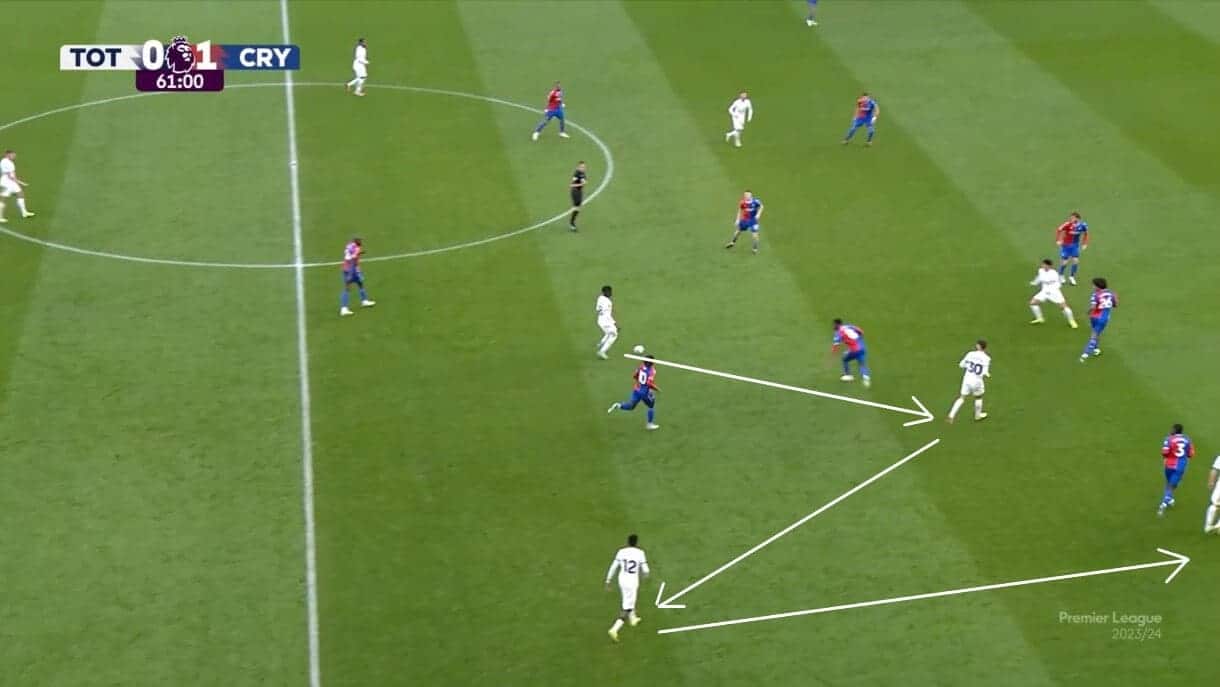
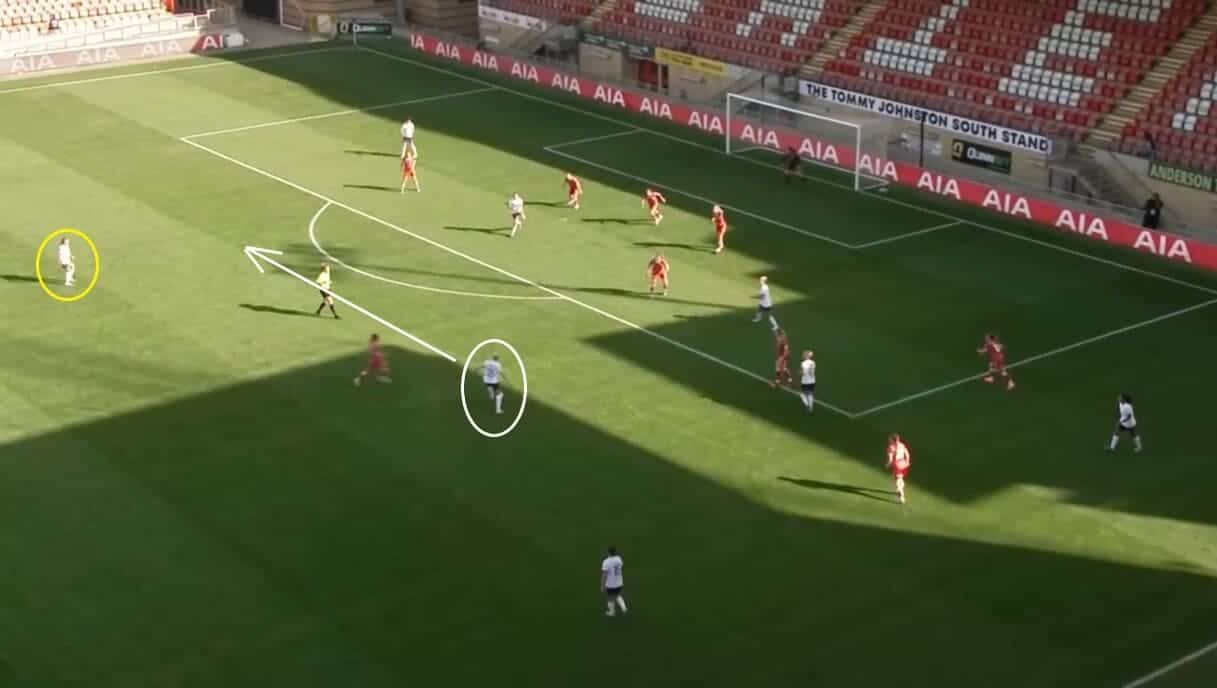
Their belief in the benefits that this could bring, particularly for their two senior teams, has been demonstrated by their desire to find coaches for each who matched the aggressive, exciting brand of football that they wanted to see implemented. There is no doubt that watching the way that both Ange Postecoglou and Robert Vilahamn have set their teams up, they have really fitted that bill.
Both share a preference for quick and well-executed transitions whenever their teams have regained the ball. This is a crucial aspect of their game plans at Celtic and BK Häcken Dam, respectively, and a major reason that both have been rated so highly as coaches in the men’s and women’s games, respectively.
Out of the two, the men’s team is the one that has needed to work harder to make it a success, with them previously being coached by José Mourinho and Antonio Conte, both of whom tended to prioritise defending over attacking, so it was more common to see the team sitting back and playing less exciting football. Postecoglou has, in many ways, reversed that mentality, with a strong emphasis on getting on the front foot and winning the ball as high up the pitch as possible, just as Yves Bissouma has done here.
Once possession has been regained, attention has turned towards making quick passes up the pitch in the manner that Bissouma, James Maddison, and Emerson Royal do here. The last of those eventually feeds the ball into the path of Dejan Kulusevski ahead of him, and the speed of that sequence really catches Crystal Palace out.
When looking at how they have constructed phases of play like this, it is not hard to see why they have registered an 86.9% passing accuracy for the season and have averaged 59.22% possession per game (up from 50.9% in 2022/23), with it clear to see how they have increased their overall threat and have worked hard on making themselves a much tougher team to contain.
The women’s team, conversely, have actually been demonstrating elements of this style of play for a while longer, with the arrival of Eveliina Summanen from Kristianstads Damer in January 2022 indicating a desire to move the ball through the thirds and to play an attractive style of football. Summanen has been a key player in making that possible since then, with her main qualities being her box-to-box and ball-playing abilities. It has been common to see her finding pockets of space like the one she has positioned herself in here against Bristol City Women in a bid to involve herself in these sequences of play.
The danger in allowing her to take up these positions is that she can now move the ball around and either take a shot on goal herself or set up an opportunity for a teammate. Her decision to do the latter here allowed her Finland international teammate Olga Ahtinen to fire past goalkeeper Kaylan Marckese.
Therefore, when looking at what was already available to him, it is clear that Vilahamn has not had to adjust too much since his arrival, but he has tidied things up, and the fact that they have registered an 83.5% passing accuracy and have averaged 50.24% possession per outing shows that they, like their male counterparts, are on the right track when it comes to controlling the flow of their matches.
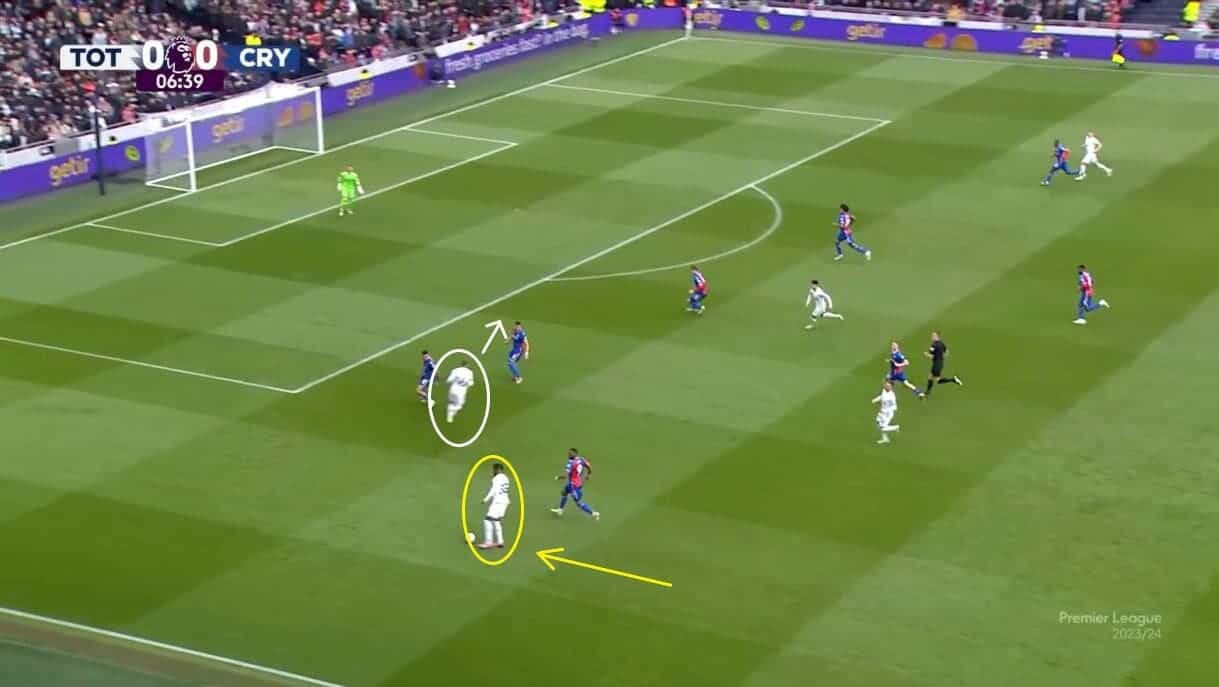
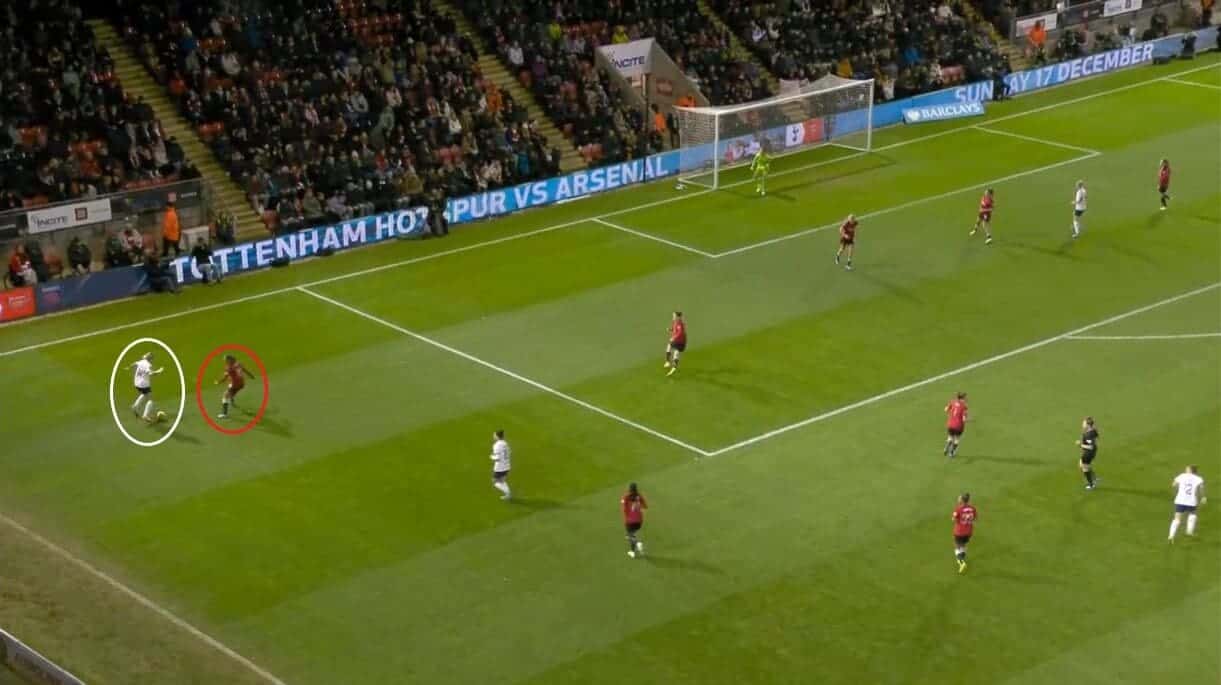
There are other noticeable similarities to their play when it comes to the way that they use their forward lines, most notably in their shared preference for wide attackers who have pace and who can offer outlets at the top of the pitch.
For the men’s team, the player to look at in this regard is Timo Werner, who joined on loan from RB Leipzig in January. The Germany striker has had an inconsistent career so far, with him impressing in some teams but struggling in others, and yet what Postecoglou has seen in him is a player who doesn’t necessarily score goals but who makes the right runs and who can therefore be used in alternative ways.
In this case, his role is to make an inside run and to create the space for left-back Destiny Udogie to carry the ball up the field. That inverted run leads to another point about how the wide forwards and full-backs interact with each other around the pitch to create additional numbers inside the final third. It is that that has led to the men’s team averaging 2.03 goals per game so far.
Vilahamn also likes players in the wide areas who don’t necessarily score but who can make intelligent runs both inside to create central overloads and who can stay wide to retain width, with newly capped England midfielder Grace Clinton impressing in that role during her season-long loan from Manchester United Women and playing her role in the team scoring 1.82 times per game.
However, others have really taken to the demands of that role, including Celin Bizet Ildhusøy, who is shown here engaging in a 1-v-1 duel with Manchester United captain Katie Zelem in a bid to get beyond her and into a position from which she can either deliver a cross or dribble it inside, herself.
When looking at the makeup of the women’s team, it is clear that they have several players who can thrive in these wide attacking roles and who have the same pace as Werner. Jessica Naz is an excellent example of someone who can cause constant damage to opposing defensive lines. Once again, Postecoglou and Vilahamn agree tactically, and the club’s dream of creating a joint brand is quickly becoming a reality.
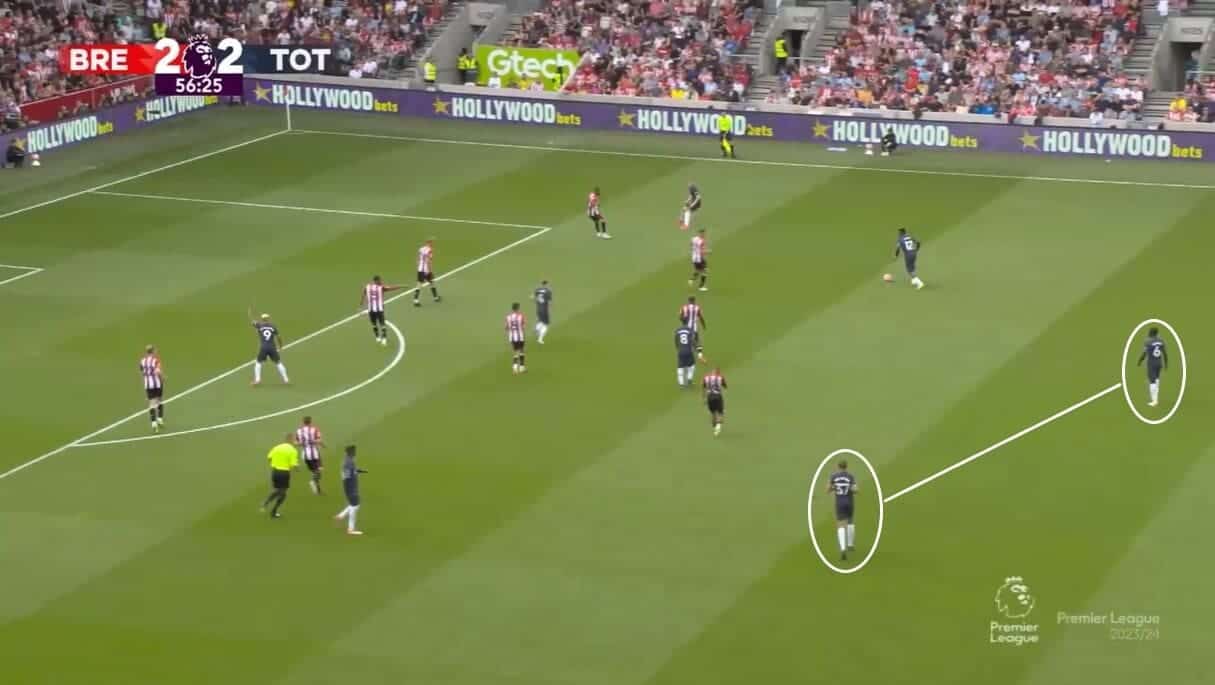
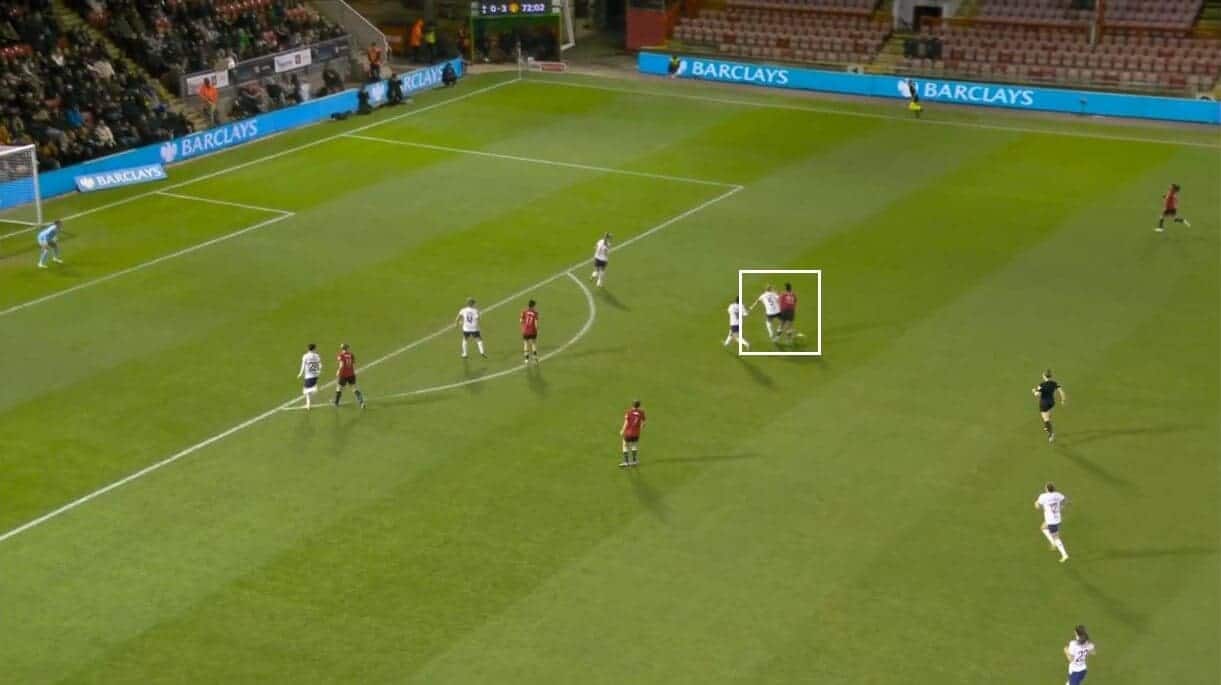
A third thing that both coaches are known for is their desire to see the centre-backs act as additional ball-playing midfielders. For the men’s team, this required them to invest in the squad by purchasing Micky van de Ven from Wolfsburg, who has quickly established himself as a key player when it comes to playing out from the back and finding teammates ahead of him. He has arguably been one of Tottenham’s most important players in their bid to be more aggressive around the field and to find new ways to test their opponents.
It was clear from his first league outing for the club, against Brentford, that he had this quality, and this was why the club pushed to sign him. He was partnered with Davinson Sánchez (who moved to Galatasaray not long after this game) and acted almost as another midfielder in Tottenham’s bid to break Thomas Frank’s side down.
When it comes to the women’s team, they already had a player in the squad capable of matching van de Ven’s profile, and it was simply a case of unlocking the potential of Molly Bartrip and finding a way to afford her the freedom to make the same runs up the field.
Tottenham did that by signing former Hoffenheim Frauen captain Luana Bühler. The Switzerland defender is a versatile operator but has a reputation for sitting back and protecting her goal while in the Frauen-Bundesliga. Her presence has led to Bartrip getting up the field in the manner that she did here, when she closed Manchester United striker Geyse down before playing the ball forward to instigate another sequence of passes up the field.
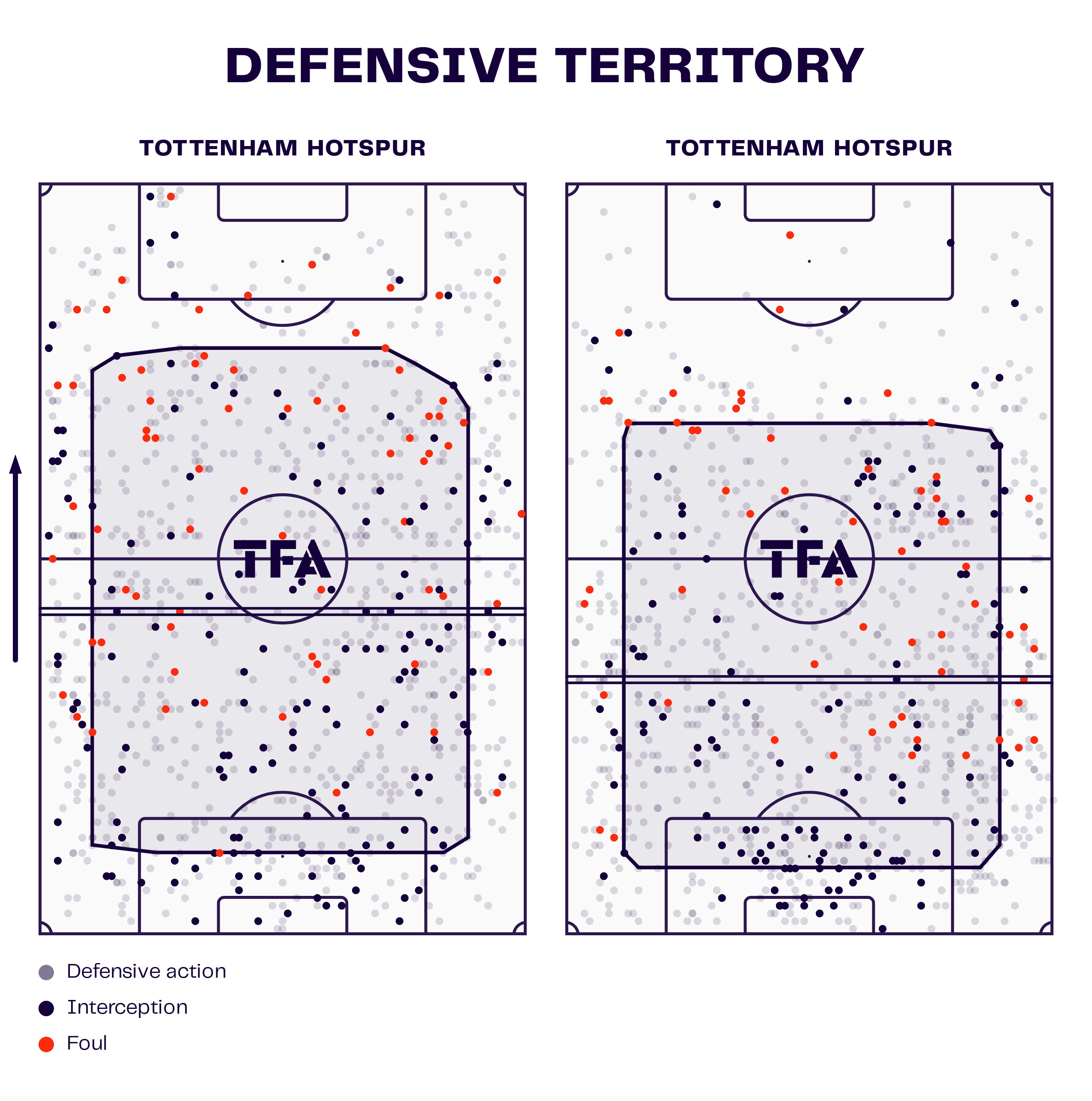
It has been mentioned that both Postecoglou and Vilahamn want their teams to be aggressive out of possession and as proactive as possible. This graphic illustrates the average defensive territory that both sides have covered in all competitions this season.
On the left is the men’s team’s graphic, and it is clear that they have tended to push higher up the field than the women’s team has, perhaps due to the latter needing to sit further back in games against some of their WSL opponents (with clear evidence in some of their outings that not doing so has led to them being opened up too easily).
However, the same basic ideas are still apparent, and Tottenham, while still new to the idea of creating a joint brand and sharing tactical ideas between their two senior sides, is going about it in the right way.
Ajax
Another club that has recently warmed to the idea of bringing their men’s and women’s teams closer together is Ajax. Those involved in running the latter stated this season that there has been an increased effort to bring them more in line with the men’s, at least from a tactical point of view, as they seek to keep growing and fighting for bigger and better things.
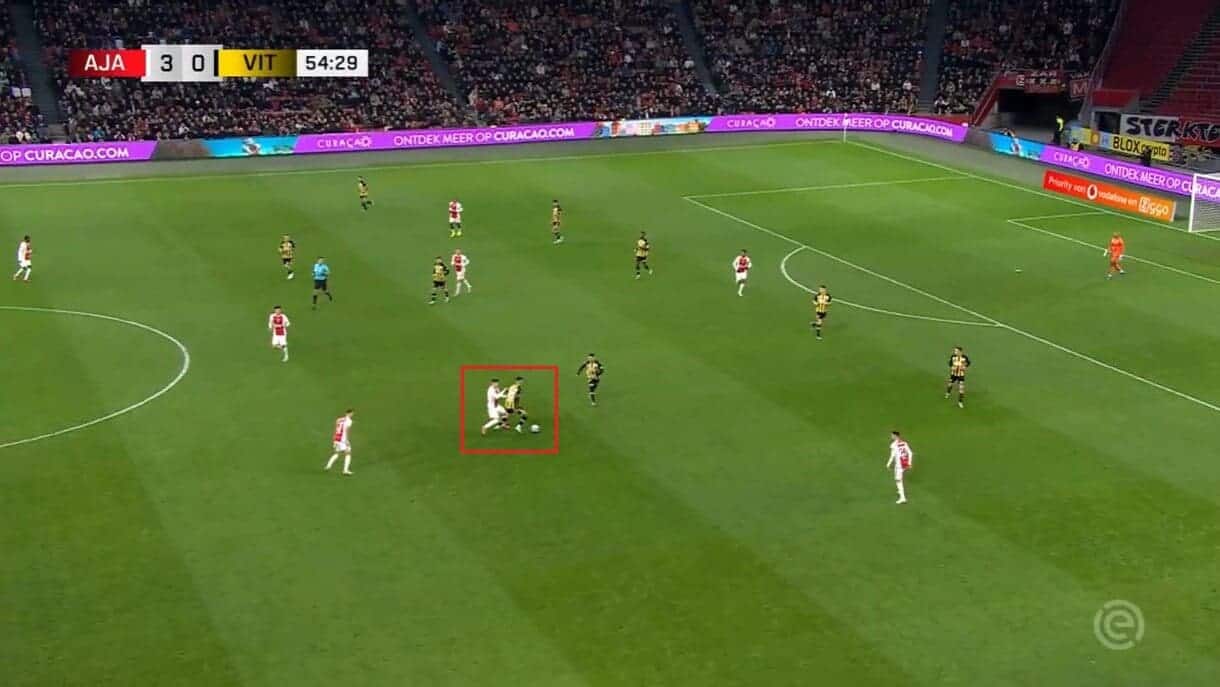
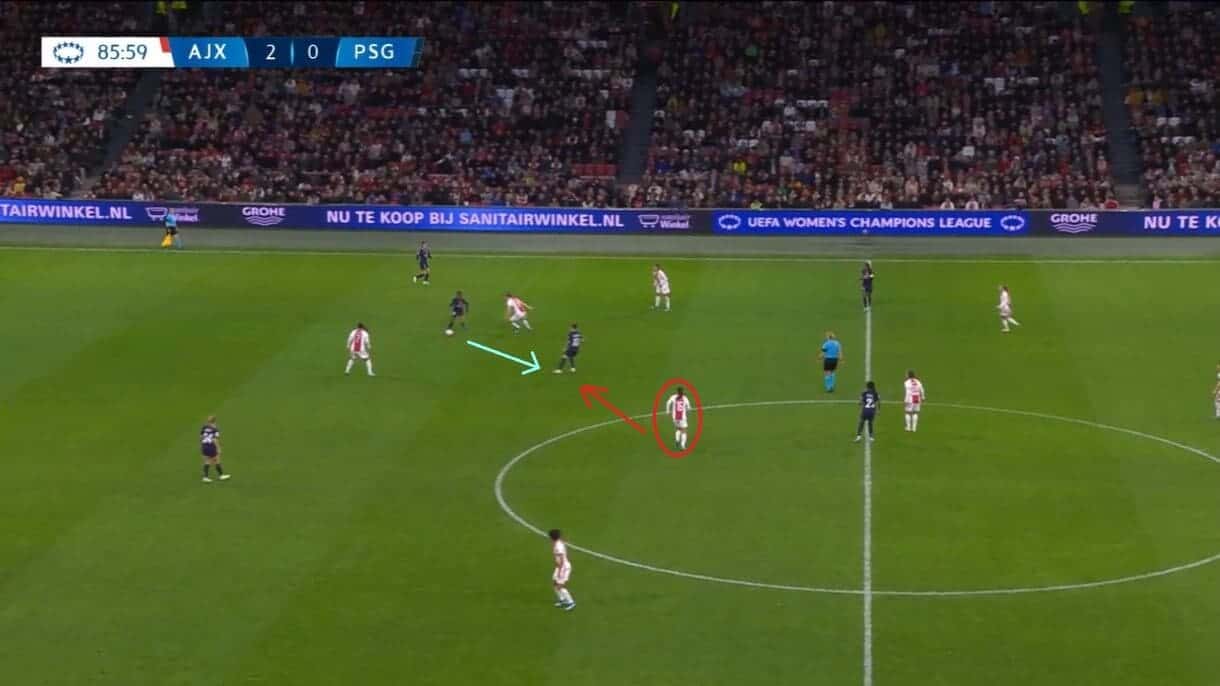
As a club, Ajax have always had a distinct way of playing. Their focus has been on pressing high to win the ball in the midfield or forward areas and playing through the thirds to create as many promising situations as possible. The men’s team has always adhered to those ideas as the years have gone by, and despite the overall disappointment of the way that things have gone, this season has been no different.
In this case, their desire to win the ball as early as possible is clearly indicated, with Vitesse Arnhem looking to build from the back and Mathijs Tielemans trying to find a teammate ahead of him. However, Ajax’s Kristian Hlynsson has recognised his intention, and the Iceland midfielder has looked to get tight to Tielemans in a bid to dislodge the ball and keep the pressure on Vitesse.
In short, there is a clear desire to play on the front foot regardless of how successful they are, and that mentality has led to them averaging 2.03 goals per game and seeing 50.8% of their counterattacks lead to shots on goal.
When it comes to the women’s team, the similarities are very apparent, with them coming up against PSG Féminine here at the Johan Cruff Arena and seeing Laurina Fazer pass to Ramona Bachmann as they look to move the ball into space and to try and fashion a goalscoring opportunity. However, the Switzerland forward is unable to make any more ground here due to Danique Noordman reading PSG’s intentions and closing her down, just as Hlynsson did for the men’s team.
This is not the only time that Ajax have used this tactic in their matches, with them seeing 67% of their counterattacks lead to shots on goal and average 1.17 goals per game. This desire to adopt the same principles as the men’s team helped Ajax not only qualify for the Champions League group stages for the first time but also reach the knockout rounds. Therefore, there are clear signs that Ajax’s ability to lend their women’s team more support has helped them to grow on the field.
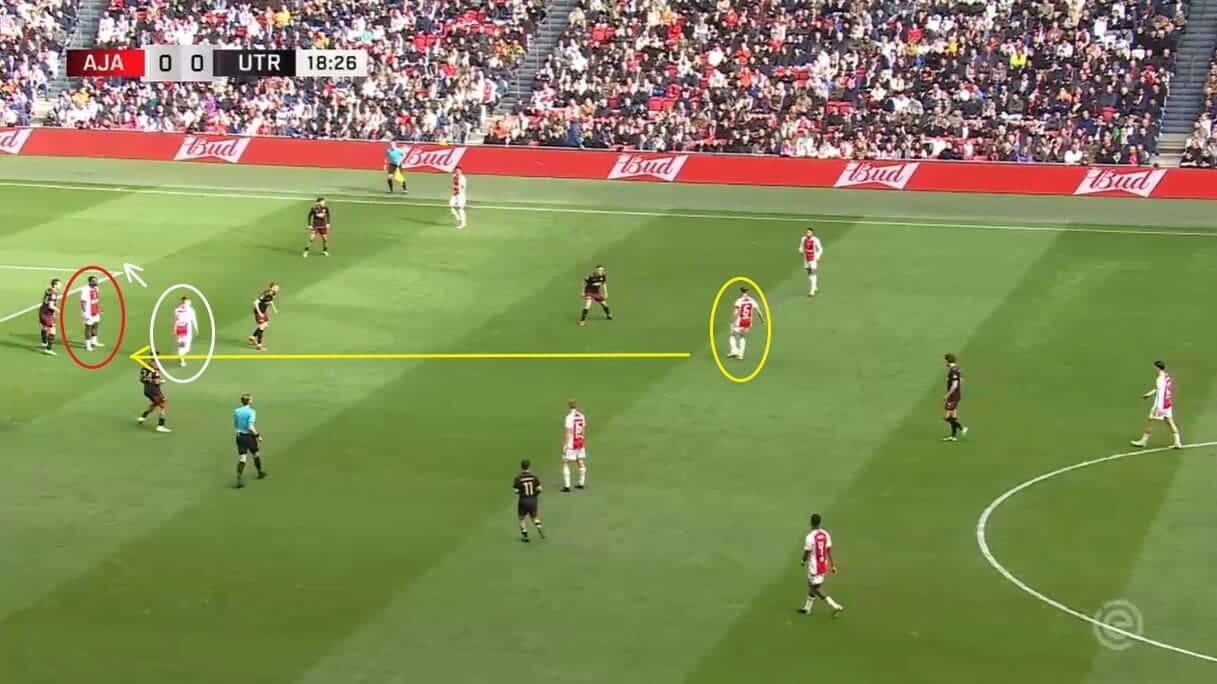
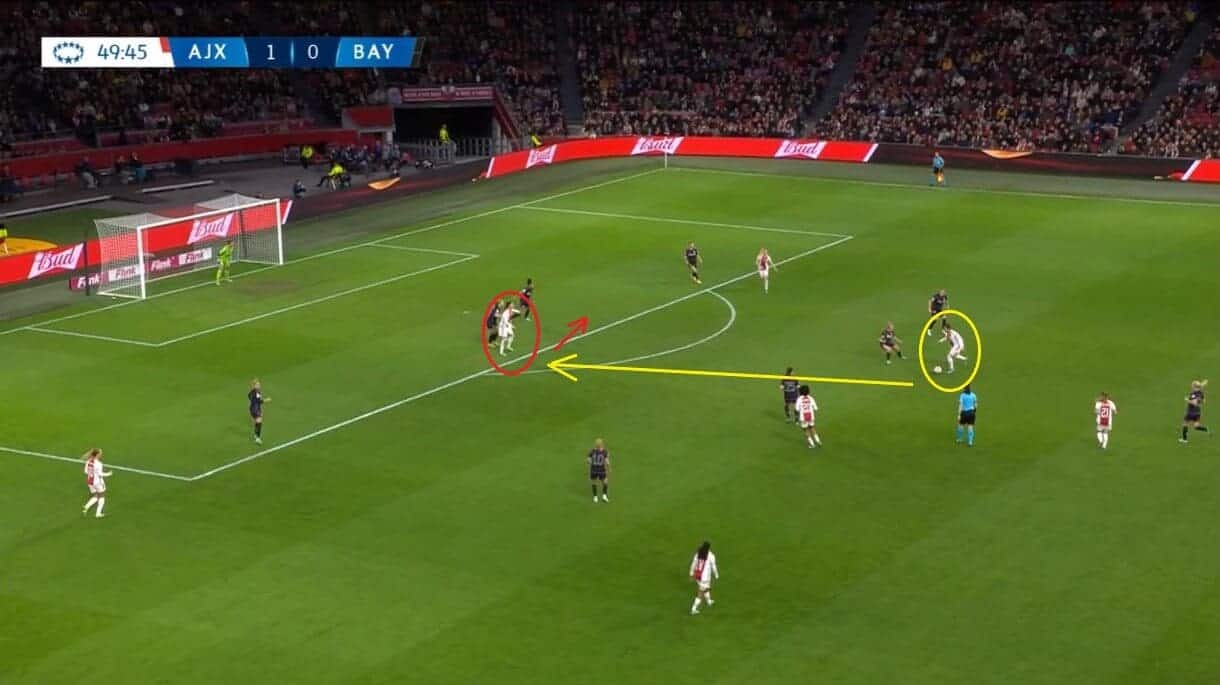
When both teams regain the ball, there is a clear desire to make the same line-splitting passes from the midfield to the forward line, and these situations highlight how both have used their strikers in the same way to make that possible.
For the men, it is Brian Brobbey who has tended to operate at the top of the pitch as an outlet, with him here receiving a pass from former Liverpool men’s captain Jordan Henderson and instantly laying the ball off for Kenneth Taylor to run across him and to send towards the Utrecht goal. It has been a common sight in Ajax’s matches to see them play a combination of long and short passes into Brobbey and then make runs off him on either side as they aim to utilise the wide areas in their build-up play. The fact that 87.2% of their passes have found their intended target shows how it has been another strength in their overall play.
The women’s team have shown virtually a carbon copy of that, with a 78.3% passing accuracy and a main striker who acts as a target player in Romée Leuchter. She too receives a pass up the field here before laying the ball off for a teammate to shoot at goal.
In this case, she is looking to hold Bayern Munich Frauen’s Glódís Viggósdóttir off whilst receiving the pass up the pitch from Chasity Grant before then laying the ball back off for Grant to get back on the end of. Once Grant receives the return pass, she sets up right-back Milicia Keijzer here to fire at goal, but the key point here is the way that Brobbey and Leuchter offer the same presence and have the same role description.
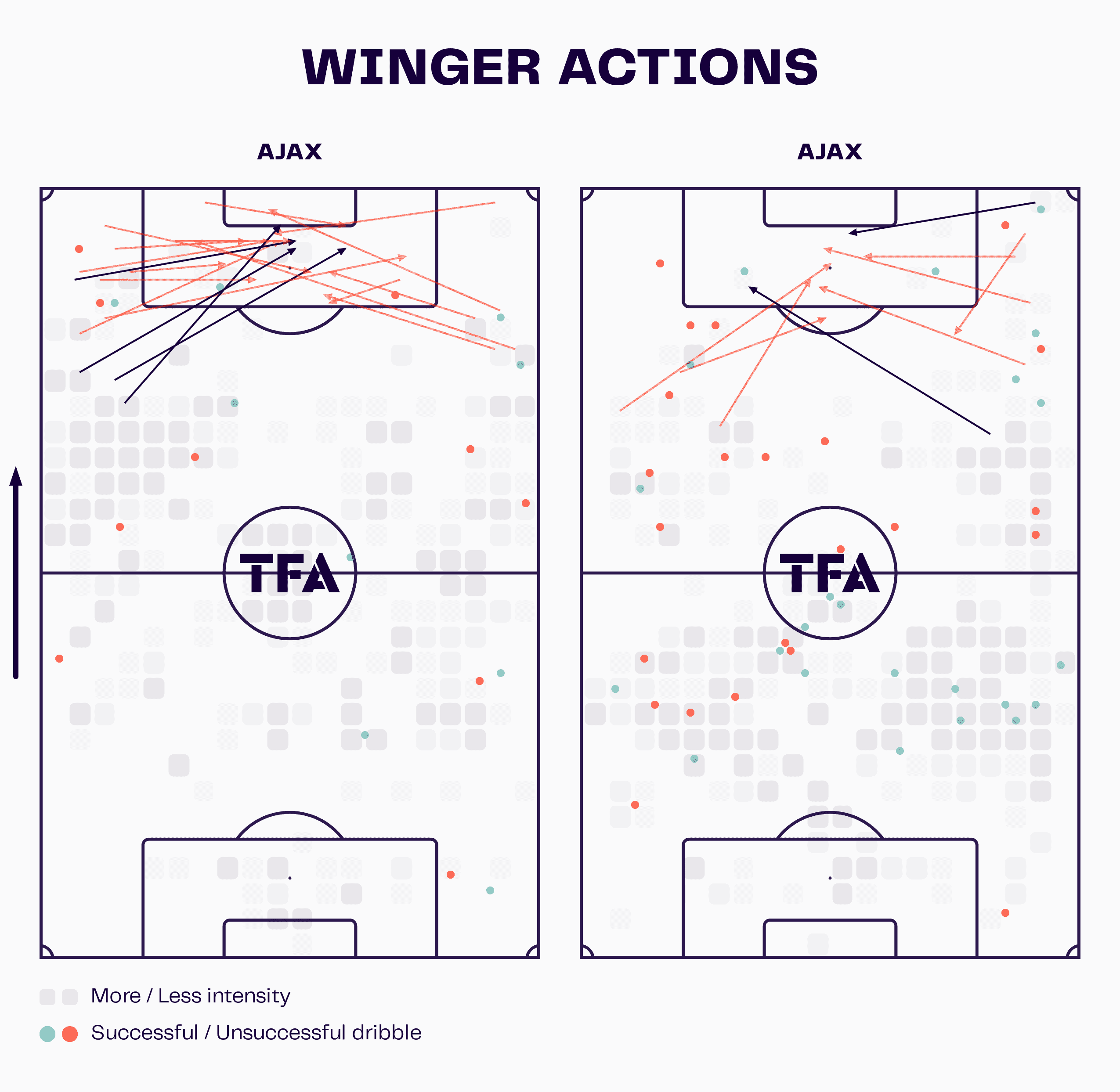
Building on that, another fundamental principle of both the men’s and women’s teams’ play has been their reliance on the wide channels when building attacks, with each having a tendency to feed the ball into those areas as they look to break their opponents down.
As the graphic shows, Ajax’s men’s team (on the left) have tended to attempt more crosses than the women’s, whilst the women’s team have looked to dribble more, and that fits with what has already been shown in this section of the tactical theory piece in that Grant passed the ball before running forward here. She and Tiny Hoekstra have tended to be a lot more mobile than the men’s team’s wide attackers, with Steven Bergwijn, in particular, tending to either cross the ball into the middle or to cut back and attempt to curl a shot in towards goal himself but not dropping back as much as Grant and Hoekstra do.
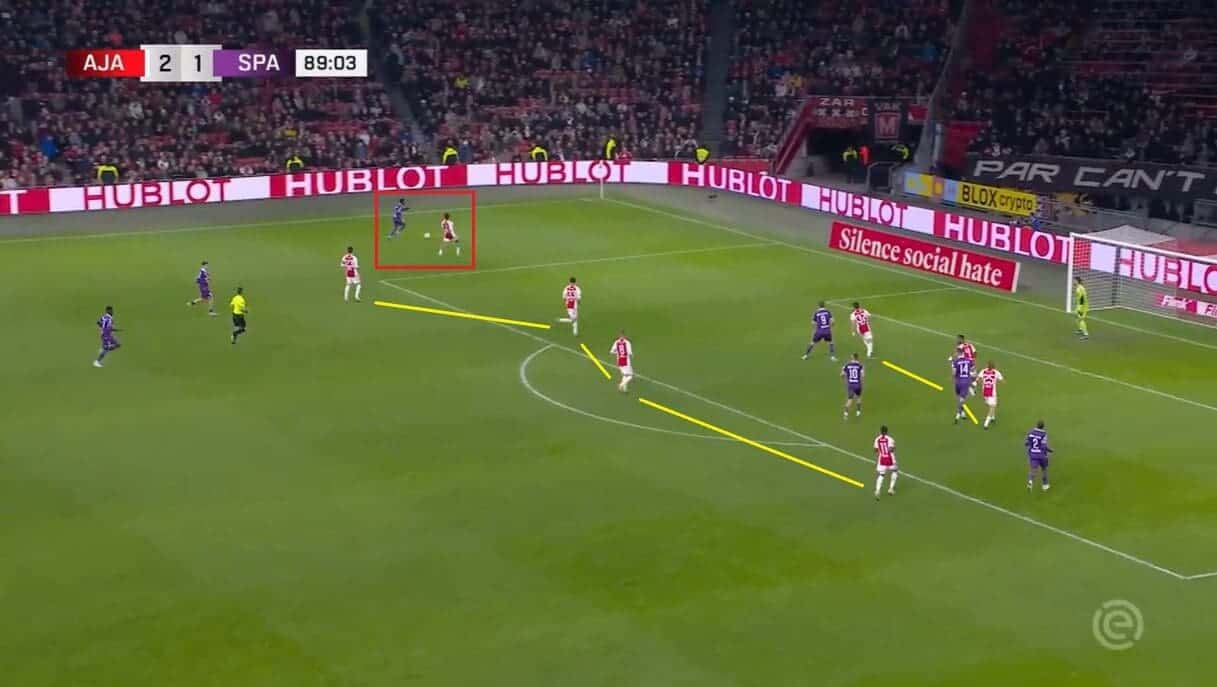
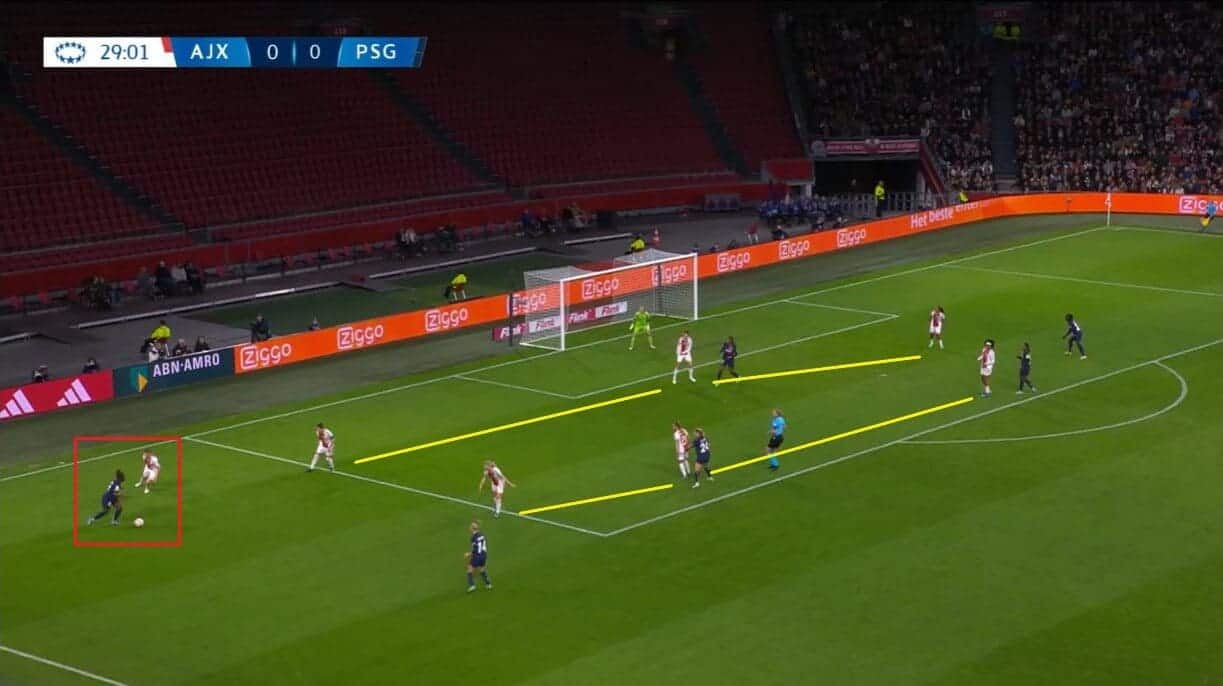
There are apparent similarities when it comes to both teams’ defensive setups, too, with them both adopting shapes that prioritise keeping as much space between the ball and their goal as possible, and that is shown in both cases here as the opposing sides have found their way into the wide space but have each been faced by an Ajax defender (for the men, Devyne Rensch has closed down Sparta Rotterdam’s Djevencio van der Kust, whilst the women’s team have seen Isa Kardinaal get tight to PSG’s Sandy Baltimore).
The other thing to point out is that both have two lines in front of goal, something else that they have each looked to implement whenever they are afforded the time to do so. For the women’s team, in particular, this has proven to be especially useful in keeping their opponents at bay during their maiden Champions League group stage campaign, with them winning 59.9% of their defensive duels.
However, it has undoubtedly benefitted the men’s team, too, with them winning 62.9% of their own defensive duels. This solidity, coupled with their desire to win the ball high up the pitch and implement other aspects of the traditional Ajax brand that both they and the women’s team now operate with, has allowed them to show some signs of recovery in what has ultimately been a campaign to forget.
Mamelodi Sundowns
Whilst both case studies in this analysis so far have come from Europe, it is essential to point out that internal cooperation like this happens all over the world, and one team who have been doing it for a while is South African side, Mamelodi Sundowns. Their men’s team have become famed for the blend of European tactics that makes up their game plan, colloquially known as “Shoe Shine and Piano”, but what is not as well known is that their women’s team have been playing in just the same way, with it clear that the club wants to ensure that the Sundowns brand really stands for something in the African men’s and women’s games.
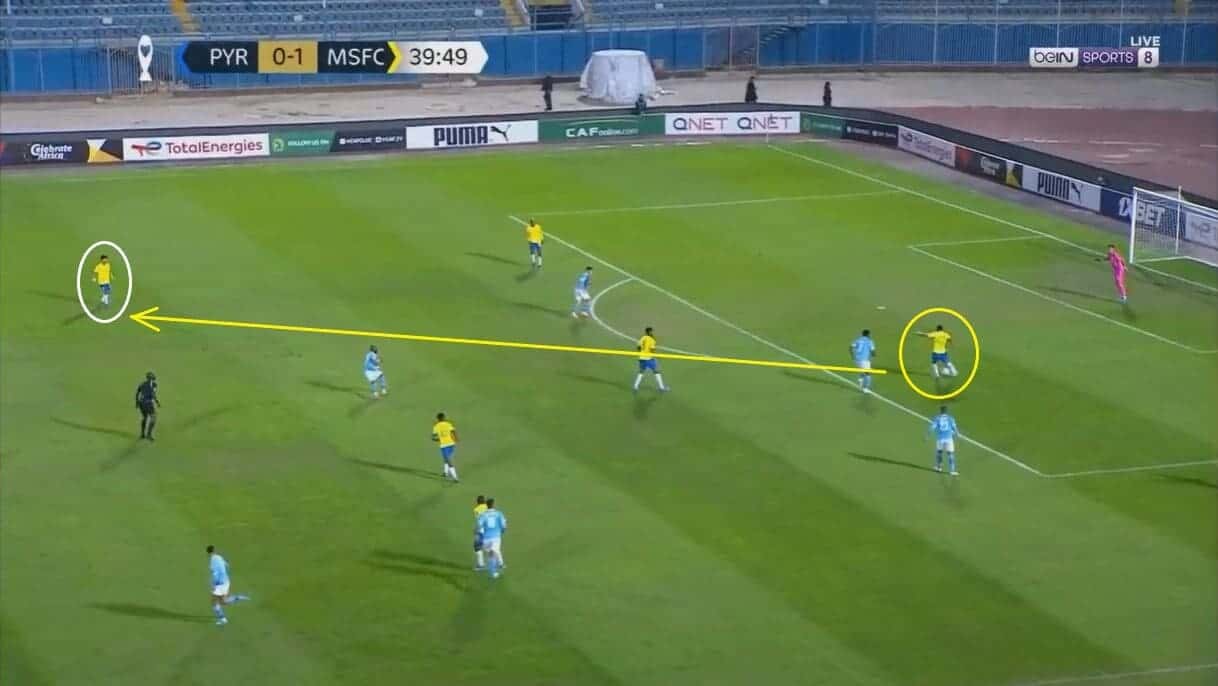
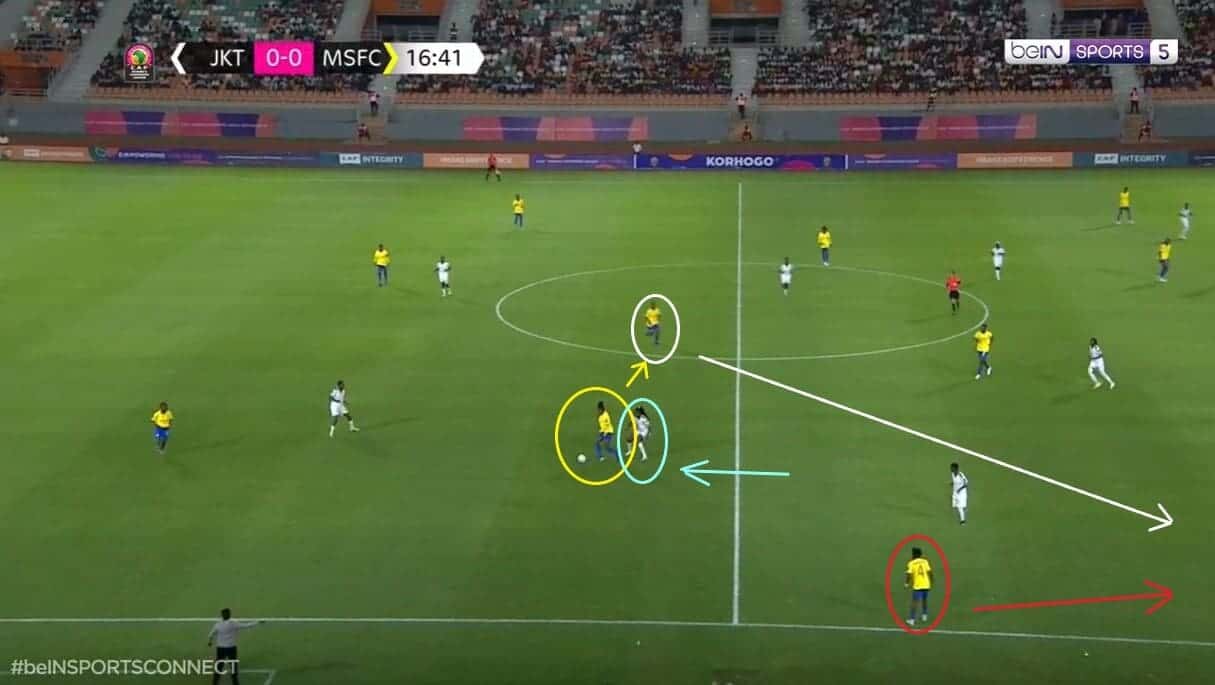
What becomes really interesting about their style of play when breaking it down as the way that Sundowns’ men’s and women’s teams can adjust the speed of their play depending on what their opponents are doing, and that really forms the basis of their tactical brand, with both sharing a desire to draw their opponents in before hitting them on the break. What has aided this is that both have shown a very high level of accuracy when moving the ball into spaces, with the men’s and women’s teams seeing 87.8% and 82.1% of their passes, respectively, find their intended targets during their current or most recent CAF Champions League campaigns.
In the men’s case, this ability to show patience and wait for the right opportunity to launch their attack was crucial in allowing them to secure a win against Egyptian club Pyramids. The Cairo-based club tends to sit back in a bid to make it as difficult as possible for the South African side to break them down.
With that in mind, Sundowns looked to keep the ball inside their own half and move it around between themselves, knowing that the temptation would become too much for Pyramids to ignore. As it turned out, that tactic paid off, as the press was eventually tested, and Rivaldo Coetzee was able to send a long ground pass towards Marcelo Allende here, allowing the Chile international to use his pace and set up a shot on the Pyramids goal.
In the women’s team’s case, the same principle has been present in their games, with it common to see them form the same structures inside their own half and wait for the chance to shift the ball behind their opponents. Against JKT Queens (a Tanzanian club based in the country’s largest city of Dar es Salaam), that came here once midfielder Joyce Lema had moved forward in a bid to get tight to Lesotho captain Boitumelo Rabale, with the latter passing the ball into Oratile Mokwena to then send through the gap and into the path of South Africa right-back Lebohang Ramalepe.
It only took two passes, but that is the devastating nature of Sundowns’ play and the fact that their men’s and women’s teams are capable of opening their teams up in the same way and of controlling possession (the men have averaged 63.88% per game in their Champions League campaign whilst the women averaged 63.3% per game in theirs) shows again how the club have worked hard to ensure that their joint brand forms the basis of both of their senior teams’ tactics.
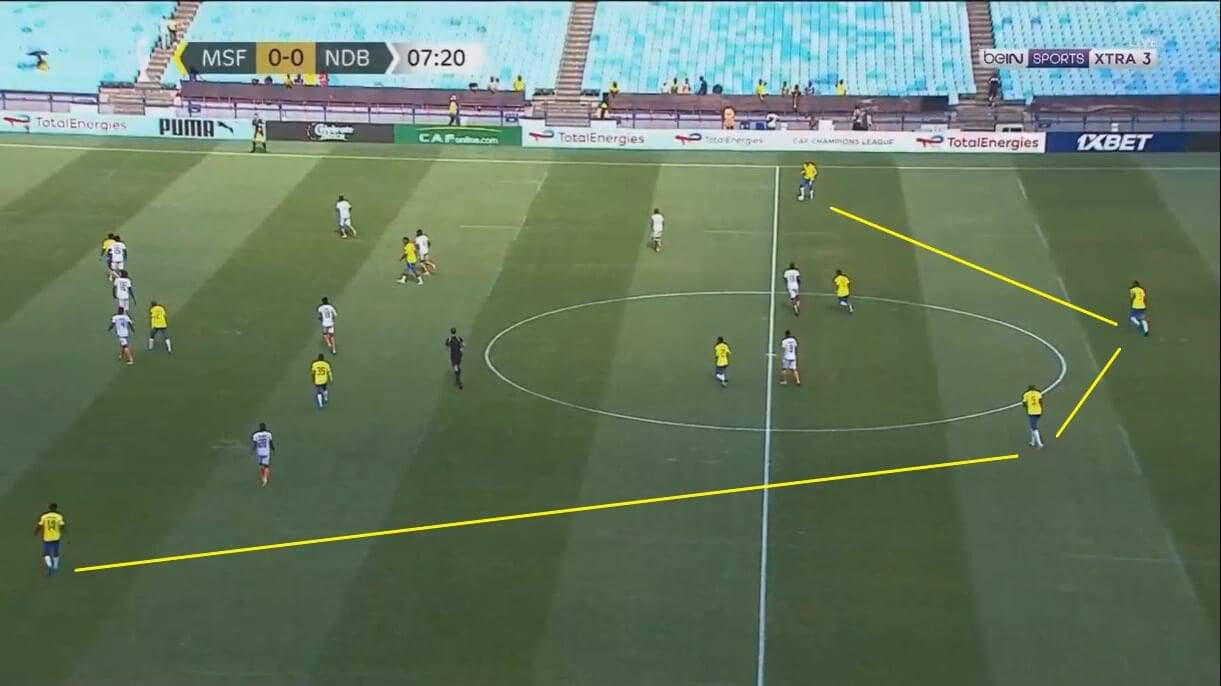
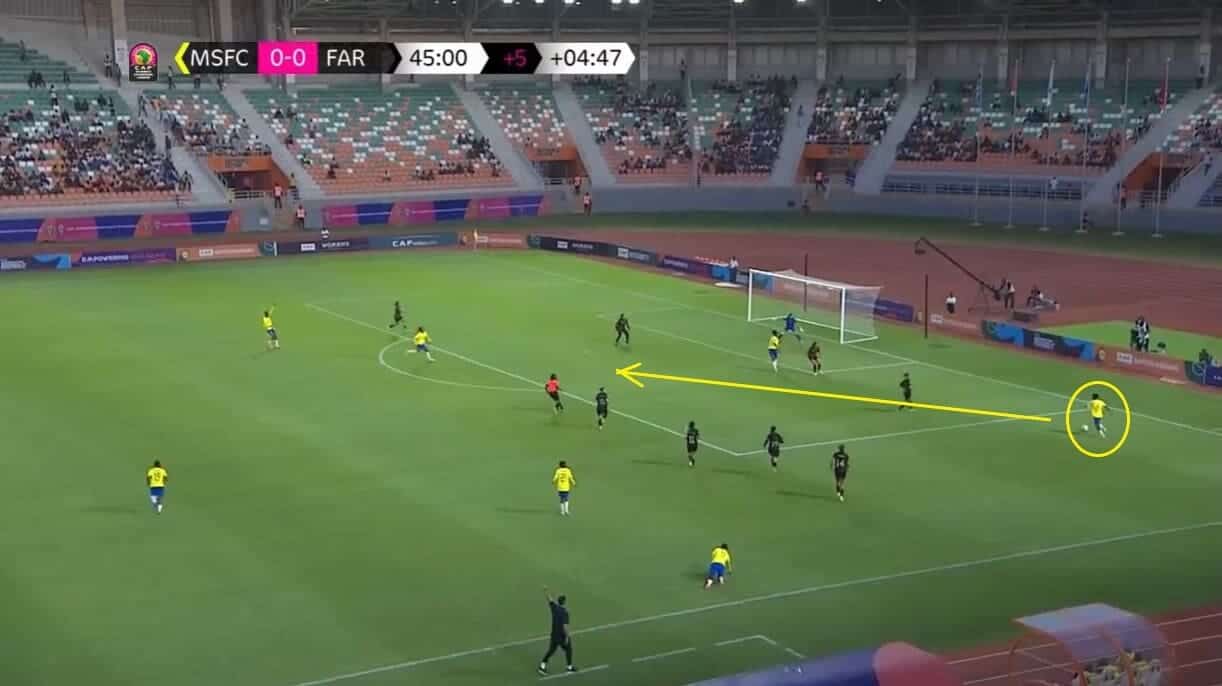
It was hinted at in the way that Ramalepe pushed up the pitch to play as an additional winger in that last situation, but another critical aspect of Sundowns’ tactics is that the full-backs play a crucial role in supporting attacks and are constantly seen pushing up the pitch during games.
In the men’s team’s case here, that has created a structural imbalance, with Terrence Mashego pushing up the pitch and positioning himself alongside the forward line, taking advantage of the space Mauritanian side Nouadhibou have left open for him to access. However, this is not a mistake and is always what Sundowns look to do whenever they have the ball, with it allowing the wingers to cut inside and to play more centrally, forming the narrow setup that is another key aspect of the “Shoe Shine and Piano” brand whilst also giving them an outlet on the wing that they can switch the ball to at the right moment.
In this case, that long diagonal pass didn’t come too soon after Mashego had got into this position. Centre-back Rushine De Reuck found him and allowed him to combine with Lucas Ribeiro Costa at the top of the pitch to fashion another goalscoring opportunity. The fact that they have seen 70.8% of their passes to the final third find their targets shows how this is not a one-off either.
It has been much the same story on the women’s side, with their full-backs also seen in the same advanced positions. This has allowed them to register a 78.6% accuracy for passes to the final third.
However, where there is a slight difference in the way that both teams set up is that the women’s team favour the use of wing-backs rather than full-backs, with their main formation during their Champions League matches in 2023 being a 3-5-2 (used in 50% of their games), whilst the men’s is a 4-3-3, which they have utilised in 49% of their outings. The likes of Ramalepe find it even easier to push up the field and to offer these passing options than the men’s team’s full-backs perhaps do.
Here, that has led to the ball reaching her inside the final third before she pulls it back for Rabale to try her luck in front of the AS FAR Women goal. Even though the effort misses the target, there is still an apparent similarity between how the men’s and women’s teams use the wings to create opportunities, and it shows once again how both are fully invested in the “Shoe Shine and Piano” ideas.
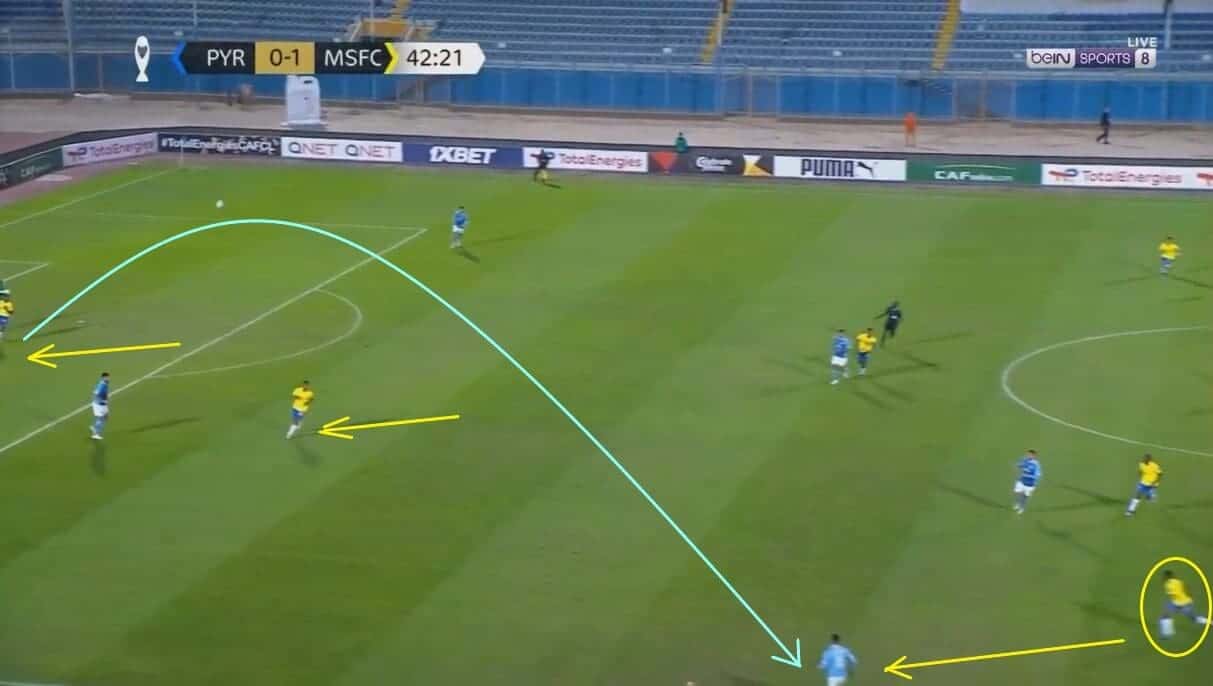
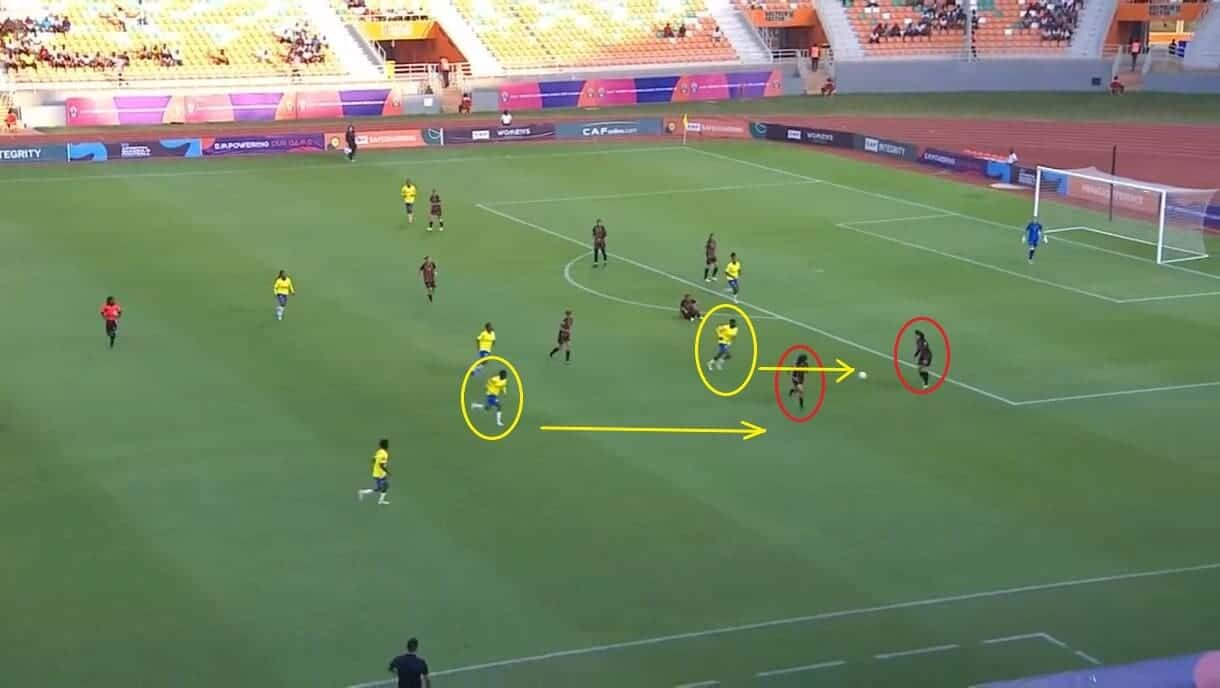
Another way the men’s and women’s teams share the same on-field principles is by pressing high up the pitch and looking to win the ball back as early as possible.
Again, this is another crucial idea in the club’s tactical brand. The fact that both of their senior teams have incorporated it into their play shows how the club has worked hard to ensure that both have the best chances to succeed on the pitch, with the men only conceding 0.17 times per game. The women didn’t concede at all on their way to becoming continental champions last year, which shows how it has helped them to become formidable opponents on the domestic and continental stages.
There are also similarities in the way that both teams initiate their press, with the men’s team sending two players forward to apply pressure inside the Pyramids goal area and the women’s team also using a combination of Nonhlanhla Mthandi and Botswana striker Refilwe Tholakele to close down AS FAR’s Morocco duo Fatima Tagnaout and Ghizlane Chhiri.
However, whereas their attempt to win the ball led to their opponents hesitating and not trying to gain any ground, the men’s team had to include a third step in their bid to regain possession, with Pyramids goalkeeper Ahmed Mayhoub clearing the initial danger towards Mohamed Chibi, but then seeing his teammate closed down by Mashego. Nevertheless, the same ideas are clear to see, and that once more highlights the tactical unity that Sundowns have implemented over the years between their senior teams.
Conclusion
In conclusion, this tactical analysis has sought to highlight how clubs in the modern game are looking to bring their men’s and women’s teams together and to introduce one brand that both can deploy. What has become clear is that it is something that so many are buying into around the world as they try to ensure that they embrace the women’s game at a time when it is growing in popularity and recognition and when those who don’t share the same views risk being left behind.
Whilst examining the case studies, what has become most evident though is that, despite them sharing the same ideas, there are still some subtle nuances between the way that men’s and women’s teams at the same club play, with each having the same basic blueprint but finding little differences here and there in the way that they either set up or use what is available to them. That is important as the vital thing about the men’s and women’s games is that they are not the same, with so many who follow or who work in the latter constantly pointing that fact out and reminding people that it is its own product and needs to be treated as such.
However, for those who want to see women’s teams gain better support and backing and a greater share of the money currently circulating around the global game, there is certainly a lot to like about where it is going. This analysis highlights clearly that, whilst there is a lot more to be done, the signs regarding how the men’s and women’s games are being given equal attention by clubs around the world are positive.





Comments